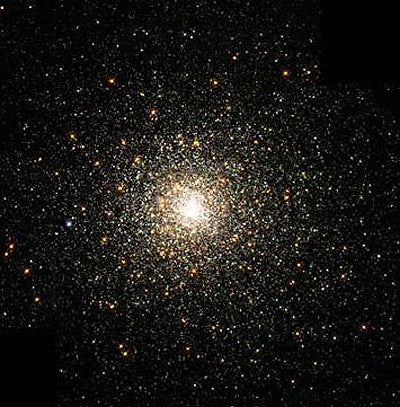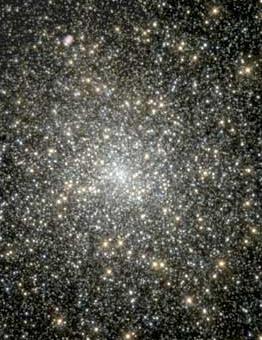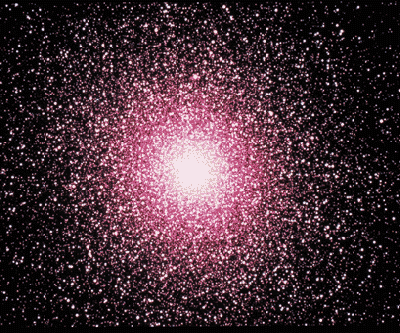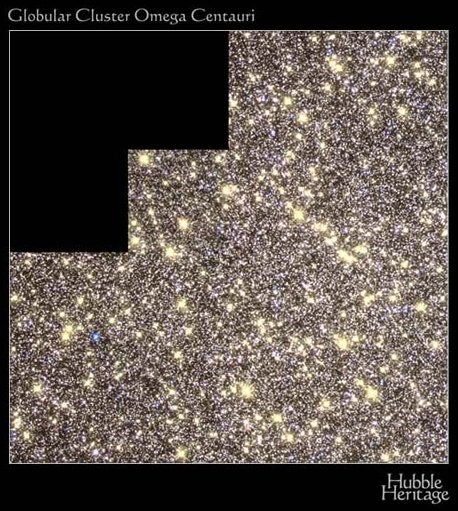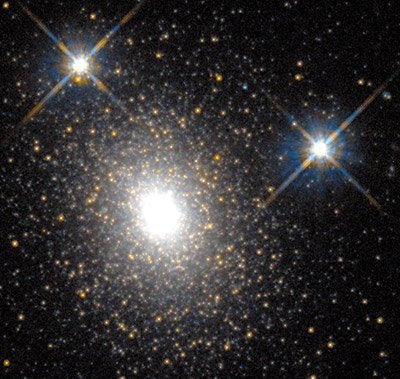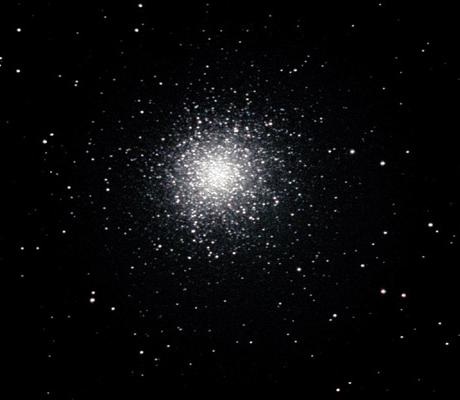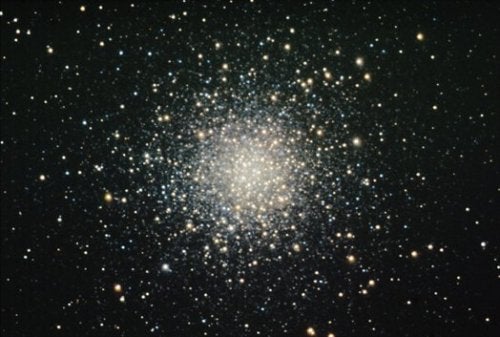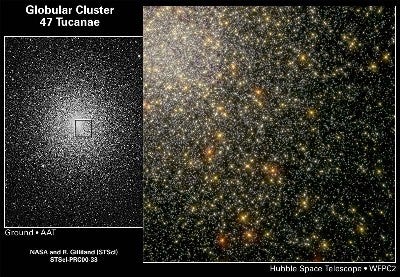Like a starry metropolis, a globular cluster packs millions of residents into an overcrowded region so unthinkably small that those of us in the galaxy’s suburbs wonder how stars could survive in such a competitive, high-pressure environment. Yet from far away, these dense stellar districts look calm and magnificent, like the towering spires of a city skyline.
These images capture the splendor of a few globular clusters. To learn more about these beautiful and complicated star clusters, read “Great balls of fire” in the November 2003 issue of Astronomy.
M80
One of the densest globular clusters in the Milky Way, M80 is located roughly 28,000 light-years from Earth and holds hundreds of thousands of stars. Every star visible in this image is either more highly evolved than, or in a few rare cases more massive than, our own sun. Especially obvious are the bright red giants, which are stars similar to the sun in mass that are nearing the ends of their lives. AURA / STScI / NASA
M15
Lying some 40,000 light-years from Earth, M15 is one of nearly 150 known globular clusters that form a vast halo surrounding our Milky Way Galaxy. The stars in M15 are estimated to be about 12 billion years old. They were among the first generations of stars to have formed in the Milky Way. Our sun, by comparison, is a youthful 4.6 billion years old. AURA / STScI / NASA
Lying some 40,000 light-years from Earth, M15 is one of nearly 150 known globular clusters that form a vast halo surrounding our Milky Way Galaxy. The stars in M15 are estimated to be about 12 billion years old. They were among the first generations of stars to have formed in the Milky Way. Our sun, by comparison, is a youthful 4.6 billion years old. AURA / STScI / NASA
Omega Centauri
Omega Centauri is one of the Milky Way’s globular cluster heavyweights, holding more than a million stars in its gravitational lock. ESO
Omega Centauri is one of the Milky Way’s globular cluster heavyweights, holding more than a million stars in its gravitational lock. ESO
Although Omega Centauri contains millions of stars (all about 12 billion years old), only about 50,000 are visible in this 13-light-year-wide HST frame. The majority of stars in this image are faint, yellow-white dwarf stars like our sun. The bright yellow-orange stars are red giants that have begun to exhaust their nuclear fuel and have expanded to diameters about a hundred times that of the sun. A number of faint blue stars are in a brief phase of evolution between the dwarf stage and the red-giant stage, during which the surface temperature is high. Stars with masses as high as that of our sun have already completed their evolution and have faded away as white dwarfs, too faint to be seen even by HST.
NASA / Hubble Heritage Team (STScI / AURA)
Center of Omega Centauri
Although Omega Centauri contains millions of stars (all about 12 billion years old), only about 50,000 are visible in this 13-light-year-wide HST frame. The majority of stars in this image are faint, yellow-white dwarf stars like our sun. The bright yellow-orange stars are red giants that have begun to exhaust their nuclear fuel and have expanded to diameters about a hundred times that of the sun. A number of faint blue stars are in a brief phase of evolution between the dwarf stage and the red-giant stage, during which the surface temperature is high. Stars with masses as high as that of our sun have already completed their evolution and have faded away as white dwarfs, too faint to be seen even by HST. NASA / Hubble Heritage Team (STScI / AURA)
Although Omega Centauri contains millions of stars (all about 12 billion years old), only about 50,000 are visible in this 13-light-year-wide HST frame. The majority of stars in this image are faint, yellow-white dwarf stars like our sun. The bright yellow-orange stars are red giants that have begun to exhaust their nuclear fuel and have expanded to diameters about a hundred times that of the sun. A number of faint blue stars are in a brief phase of evolution between the dwarf stage and the red-giant stage, during which the surface temperature is high. Stars with masses as high as that of our sun have already completed their evolution and have faded away as white dwarfs, too faint to be seen even by HST. NASA / Hubble Heritage Team (STScI / AURA)
G1 in the Andromeda Galaxy
G1, located 2.2 million light-years away in the neighboring Andromeda Galaxy (M31), has a total mass of 10 million suns, making it one of the most massive globular clusters known. The Hubble Space Telescope uncovered evidence of an intermediate-size black hole about 20,000 times more massive than our sun in G1’s core. NASA / Hubble Heritage Team (STScI)
G1, located 2.2 million light-years away in the neighboring Andromeda Galaxy (M31), has a total mass of 10 million suns, making it one of the most massive globular clusters known. The Hubble Space Telescope uncovered evidence of an intermediate-size black hole about 20,000 times more massive than our sun in G1’s core. NASA / Hubble Heritage Team (STScI)
This image of the globular cluster M13 was taken from the San Fransisco Bay area using a Meade Pictor 1616XTE CCD and a Meade LX200 8-inch classic (reduced to f/6.3). A Meade 616A color wheel, and 201XT autoguider were also used to capture the LRGB image (three clear 60-second exposures, three red 60-second exposures, three green 60-second exposures, three blue 60-second exposures combined).
Glenn Spiegelman
M13 (The Hercules Cluster)
This image of the globular cluster M13 was taken from the San Fransisco Bay area using a Meade Pictor 1616XTE CCD and a Meade LX200 8-inch classic (reduced to f/6.3). A Meade 616A color wheel, and 201XT autoguider were also used to capture the LRGB image (three clear 60-second exposures, three red 60-second exposures, three green 60-second exposures, three blue 60-second exposures combined). Glenn Spiegelman
This image of the globular cluster M13 was taken from the San Fransisco Bay area using a Meade Pictor 1616XTE CCD and a Meade LX200 8-inch classic (reduced to f/6.3). A Meade 616A color wheel, and 201XT autoguider were also used to capture the LRGB image (three clear 60-second exposures, three red 60-second exposures, three green 60-second exposures, three blue 60-second exposures combined). Glenn Spiegelman
M10
Globular cluster M10 is in Ophiuchus. Bob and Janice Fera created this image with a Parallax Instruments 12.5-inch Ritchey-Chrétien telescope at f/9 and an SBIG ST-10XE CCD camera. The image is an RGB composite of 15, 15, and 15 minutes, respectively. The images were taken at Mt. Pinos, California on June 28, 2003. Bob and Janice Fera
Globular cluster M10 is in Ophiuchus. Bob and Janice Fera created this image with a Parallax Instruments 12.5-inch Ritchey-Chrétien telescope at f/9 and an SBIG ST-10XE CCD camera. The image is an RGB composite of 15, 15, and 15 minutes, respectively. The images were taken at Mt. Pinos, California on June 28, 2003. Bob and Janice Fera
47 Tucanae (NGC 104)
The ground-based image of globular cluster 47 Tucanae (NGC 104) on the left includes a box showing the region of the Hubble Space Telescope image on the right. D. Malin (AAO) / NASA / R. Gilliland (STScI)
The ground-based image of globular cluster 47 Tucanae (NGC 104) on the left includes a box showing the region of the Hubble Space Telescope image on the right. D. Malin (AAO) / NASA / R. Gilliland (STScI)

